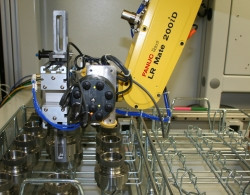22º out. 2014
The newest addition to the Gleason family is Distech Systems Inc., the Rochester, NY based manufacturer of factory automation systems used to automate load/unload operations as well as provide secondary operations such as part washing, inspection and marking.
Distech’s automation systems can be found in hundreds of gear- and non-gear installations throughout the automotive, aerospace, pharmaceutical, injection molding and other industries. The company has grown rapidly over its 22 year history by offering users tray-type parts load/unload systems that deliver many significant benefits over simple conveyors. Distech Vice President and General Manager Dan Schwab is particularly excited about what the future holds for his company, now part of Gleason. Here’s what he had to say in a recent interview…
Q. Tell us about your company’s experiences with Gleason, and gear production in general.
A. For a number of years we’ve supplied Gleason with our tray loader systems in support of their systems. It’s been a great fit for many reasons. Quality of course is paramount in gear production, and our ability to offer solutions that automate load/unload from a stackable tray system where parts are securely nested to prevent part-to-part damage is a real advantage vs. typical conveyor systems. Our systems also are easily configurable to accommodate different gear types, sizes, and operations, so they plug nicely into any of Gleason’s very wide range of machine types – as well as non-Gleason machines like turning and machining centers that might be part of a total system.
Q. For those that haven’t seen a Distech System in operation, give us a layman’s explanation of how they function, why they’re a better solution then conveyors.
A. They say necessity is the mother of invention. Conveyors do a good job of ‘conveying’, but users increasingly want much more from their parts handling equipment. With our systems, parts are protected from contact in trays – either designed and manufactured by us or supplied by the customer. An operator pushes a cart or dolly with a stack of ‘green’ parts in trays into an elevator bay, and then our systems do the rest. A 6-axis robot typically feeds parts directly into the machine’s chuck, spindle, fixture or the machine’s loader itself and then removes the part after machining. Parts often go through a secondary operation (washer, inspection, marking, etc.) and then are placed in trays, stacked on a cart and transported by the operator to the next operation.
With conveyor systems, throughput suffers because you’re only as fast as your slowest operation. Too often machines can sit idle waiting for parts to arrive from upstream. Our systems help ensure that parts are always in the queue at each operation.
Q. You mentioned secondary operations. How significant are they to today’s manufacturers?
A. The ability of our systems to integrate not only typical secondary operations like parts washing but also capabilities like laser parts marking and video cameras is increasingly important in industries like aerospace, automotive and pharmaceutical, where tracking and accountability are critical. The bottom line: with our stackable tray loaders end users have many more options then with conveyor automation.

